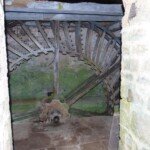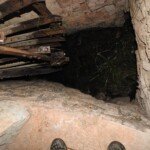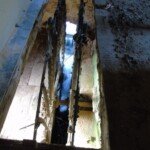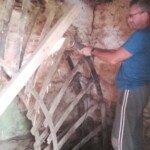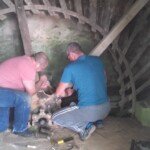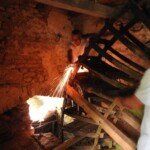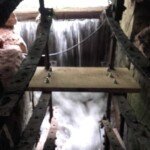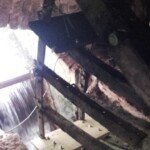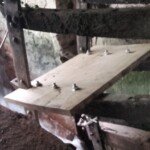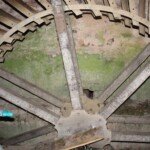Renovating the Old Mill Wheel
When Simon and Sara took over Le Petit Moulin in June 2016, one of the first jobs Simon wanted to do was get the old mill wheel back up and running. The wheel was in a very sorry state. The previous owners had intended to repair it, but never got round to it. Unfortunately, on inspection, only the metal frame of the wheel looked fully intact. Plus the bottom half of the wheel was totally encased in hard, compacted silt, about 2 metres thick. So the first task would have to be chipping away the silt to check what was left of the frame. Then we could see whether the ancient wheel would actually turn.
Replacing the paddles
Over the next few weeks, after the silt had been removed, they started the arduous task of removing the bolts. The rusty bolts were holding what was left of the frame and paddles in place. Because they were rusty, all 400 of them had to be ground off by hand. It also became apparent that all of the hole positions for the paddles were not equally spaced. So each paddle had to be individually measured and cut to size.
Fortunately, although the previous owners hadn’t started the mill wheel restoration, they had bought new nuts and bolts. And there was enough oak to replace the paddles. It still meant new oak was required for the spokes of the wheel though. These would have to be cut and planed to fit into the slots.
Reshaping the mill wheel
Altogether, it took around 70 man hours to measure, cut and fix all the spokes and paddles in place. The wheel looked great, but it still wouldn’t turn. Over the years, the wheel had twisted and it was no longer a true circle. It could easily have been damaged by large branches floating down the river, crashing into the wheel when it was spinning fast during heavy downpours. It took another 20 hours of planning and work to change the paddles and reshape the wheel, until finally it turned on its own.
Once the wheel turned, the old wheel bearing had to be changed. We then focused our attention on freeing up the smaller wheel and cogs in the back of the mill house. Using blow torches, cans of oil and a lot of hammering, we eventually manage to get all the wheels and cogs turning effortlessly.
Grinding stones
Finally, when we opened the water into the mill race, to our enormous delight, the wheel began to turn. As did the rear wheel and both the grinding stones upstairs in the mill house. It was probably the first time that the grinding stones had moved since WW2. During the second World War people would come from all the neighbouring villages to use the mill. When there were shortages of food, they would grind ‘flour’ from anything, including walnuts, which are plentiful in this region.
Regular Maintenance
Nowadays, we perform regular checks and maintenance on the wheel to make sure it continues to turn smoothly. We make sure there are no branches caught up in it, and no accumulation of silt. Or anything else that can damage this amazing piece of history and engineering.
Next time you visit Le Petit Moulin, if you are lucky you might see this incredible mill wheel in action.
The Old Mill Wheel Poem, by James Avis Bartley




